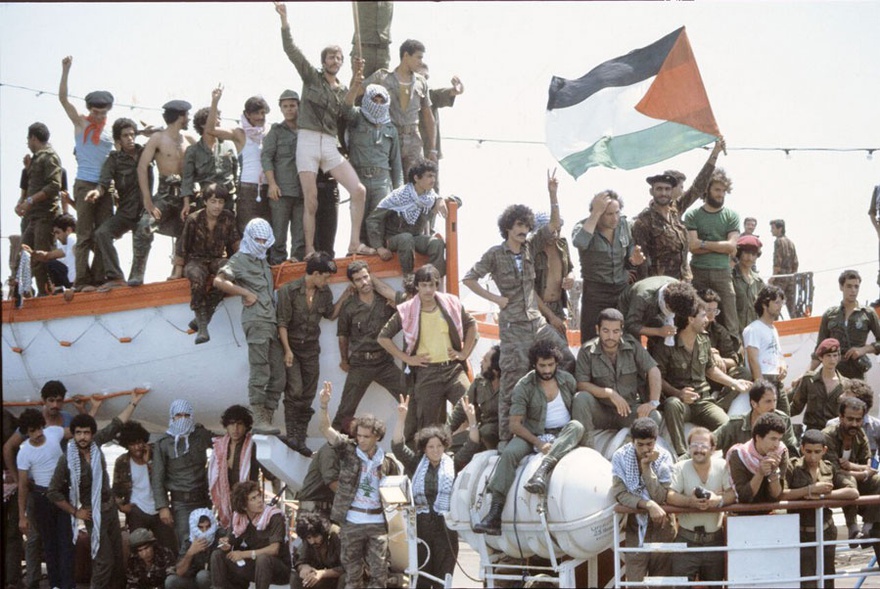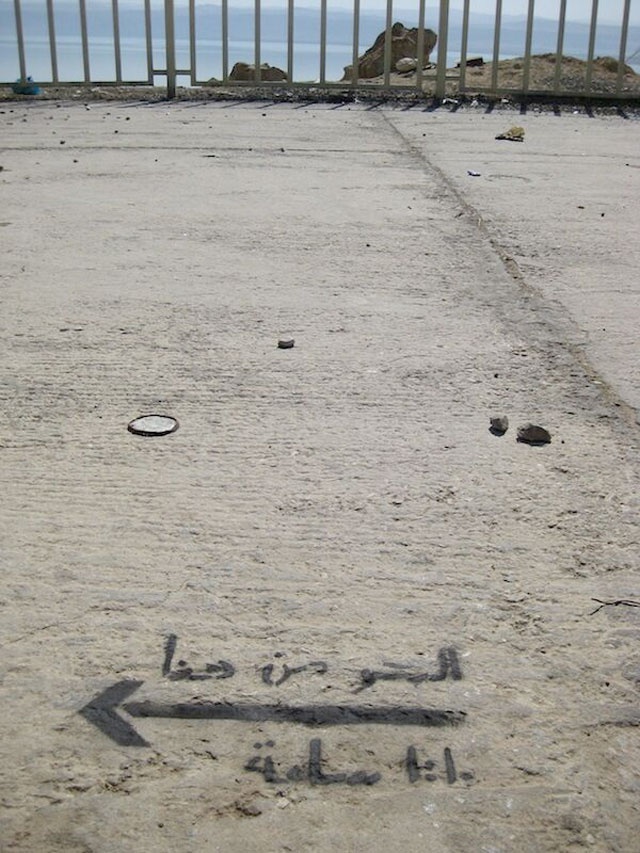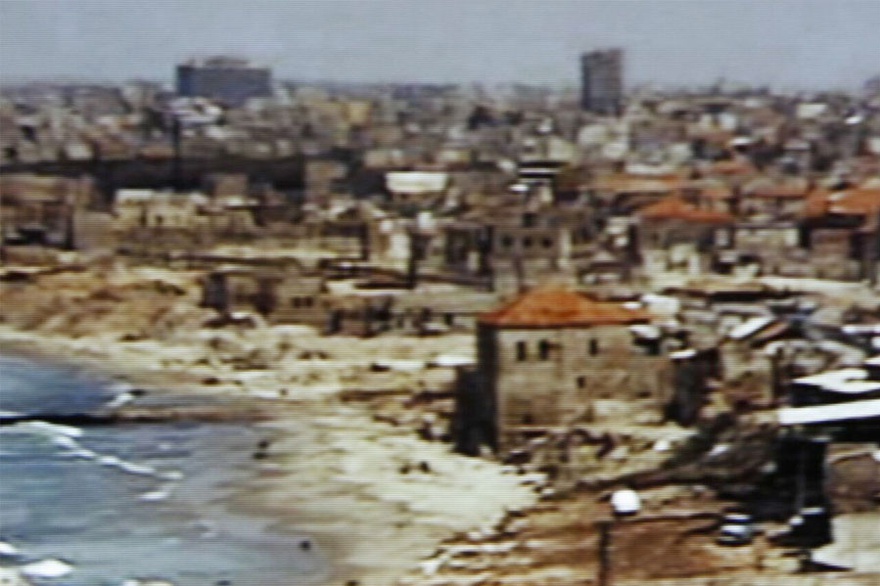Publications
Qalandiya International 2016
Sea of Stories: Beirut
Sea of Stories
Location: Beirut, Lebanon
Venue: Dar El-Nimer for Arts and Culture, America St., Clemenceau.
Dates/Times: Open daily from 11:00–19:00. Closed on Sundays. Runs through 31 October, 2016
Organizers: Dar El-Nimer for Arts and Culture
Click on the names below to visit each artist's section
Curatorial Statement by Rasha Salah, Curator
Abdul Rahmad Katanani, Ahmad Barclay & Hana Sleiman, Dictaphone group, Kamal Aljafari
Rasha Salah, Curator
Where should the ships sail after the last shore? Sea of Stories will explore the displacements and imagined returns of the Palestinian community in Lebanon throughout the Mediterranean Sea. For Palestinians in Lebanon, Palestine exists at the southern end of the shores we inhabit. It is no coincidence that the vast majority of Palestinian camps and gatherings lay on coastal cities, and some fall directly on the shore. The Mediterranean Sea is a site that bears testament to these journeys of displacement as well as possible routes of return. For the community of half a million Palestinians in Lebanon, these routes all originated from Palestine, but they did not always lead back to it. Sometimes they led to Tunisia, Syria or Cyprus in an attempt to find shelter in an ever- diminishing horizon for the Palestinian national movement. One watershed moment was that of PLO ships leaving Beirut's ports in 1982, an image that is etched onto the collective memory of Palestinians everywhere.
In recent years, sea routes have been those of immigration as opposed to return, leading Palestinians further away from home. Along with other refugee and migrant communities from around the Mediterranean, entire families took to the sea in search of a different life on Europe's southern shores. The Palestinian experience and imagination has travelled the Mediterranean, temporarily setting anchor in several of its ports, and perpetually seeking the route back to Palestine. In the words of Palestinian poet Tawfiq Zayyad, Palestinians have continued to 'plough the sea' in a relentless effort to return.
The exhibition seeks to explore those journeys and trace these routes, opening a space for conversation on what return means for today's Palestinian community in Lebanon. It sets sail from the ports of Tripoli, Beirut, Sidon and Tyr to retrace the journeys of people, ideas, narratives and objects across the Mediterranean. It tries to draw attention to the labour invested in imagining geographies and scenarios of return, and tries to provoke a conversation about what such a scenario would look like.
The sea looms large in the language of our imaginations, a site of reflection, voyage, and volatile freedom. It exists as both surface and metaphor. Through it dreams are dreamt, journeys are set forth, and the horizon of life begins to blur and widen. But the sea opens itself to both naval commander and refugee; it is the means of both conquest and escape. Today we face the sea in an era of occupations, wars, massacres, and mass displacement. Those who have taken to the sea in flight have been met with a second set of dangers: live bullets in Gaza, drowning in the Mediterranean. The sea that shimmers with possibility becomes a site of horror. And so the wave seems to blur into the very tools of these human-made borders: barbed wire.
The story of the archives of the Palestinian national movement reveals a narrative of exile and fragmentation that reflects the Palestinian experience itself. Building on archival and ethnographic research, this project will reconstruct the journeys of these archives across the Mediterranean, connecting locations including Beirut, Haifa, Algeria, Cyprus and Italy. It will explore how much of these archives have been lost, why the remaining fragments are yet to be repatriated, and the ramifications of an archival absence on Palestinian narratives of past, present and future.
A combination of physical installation and digital projection will immerse visitors in the story of these archives. The installation will trace the displacement of the archives through time and space, capturing and animating the stories of – and fragments from – the archives themselves, to create an immersive and living experience.
Rachidiyye Palestinian refugee camp is located in south Lebanon, to the south of the city of Tyre. It is the closest Palestinian refugee camp to Palestine and is situated on the seafront bordering the Tyre Coast Reserve. Starting from the declaration of one resident that, 'The sea is one of my best friends', we worked with four residents of the camp mapping their everyday routes from their homes to the sea. Narrating stories, each participant lead us towards the final scene in which they place themselves with the background of the sea.
The Israeli and American features shot in the town of Jaffa from the 1960s to the 90s are the basis for the story of a dream. All protagonists are removed from the original footage, leaving an empty setting formed by the town. Thus, the impossible is made possible from the 'I' perspective, namely filming the past and compiling a picture album made of memories.
Preserved also is a city, alive again in moving images. Its gradual destruction over the decades is chronicled by film, excavating a whole community and recreating the city. Aljafari erased the actors, photographed the backgrounds and the edges; and made the passersby the main characters of this film. He finds his way from the sea, walks everywhere, sometimes hesitant and sometimes lost. He wanders through the city and memories filming everything he encounters because he knows it no longer exists. He returns to a lost time.
Kamal Aljafari's filmography includes Recollection (2015), Port of Memory (2009) and The Roof (2006). In 2009–10 he was the Benjamin White Whitney Fellow at Harvard University's Radcliffe Institute and Film Study Center. He has taught at the New School (New York, 2010) and at the German Film and Television Academy in Berlin (2011–13), where he also served as head of the directing programme.
Ahmad Barclay is an architect and visual communicator. He has led award-winning infographics projects with Visualizing Impact, facilitated workshops in multiple cities, and worked on major architectural projects. Ahmad previously worked with DAAR, Bethlehem, investigating architectural models for Palestinian return. His academic research focused broadly on the role of architecture as a tool of 'spatial resistance'. He holds an MPhil in Environmental Design from the University of Cambridge.
Hana Sleiman is a researcher and archivist. Her work focuses on archive creation and appropriation in modern Palestinian history and its effects on the competing narratives on Palestine. Sleiman received her MA from Columbia University's Department of Middle Eastern, South Asian and African Studies in 2013. She was a Special Collections Librarian at the American University of Beirut Library Archives from 2014–16.
Dictaphone Group is a research and performance collective that creates live art events based on a multidisciplinary study of space. It is a collaborative project initiated by live artist Tania El Khoury and architect/urbanist Abir Saksouk. Together with artist and performer Petra Serhal, they have been creating site-specific performances informed by research. The aim of these projects is to question our relationship to the city, and redefine its public space.
Abdulrahman Katanani (b. 1983) grew up in Sabra refugee camp in Beirut. He is an artist whose work is noted for its intensity in portraying a vivid recollection of stories amassed throughout the years that initially depict the tragedy and hardships endured at the camp. Through his work, he delivers the camp's message of resistance and endurance using tools from the camp that resonate happiness, apathy, empathy, tears and joy.
Rasha Salah is the Executive Manager of Dar El-Nimer, a nonprofit foundation that opened in Beirut in May 2016. A graduate in Social and Cultural Development from Bordeaux II, France, she was Grant Manager at the Arab Fund for Arts and Culture from 2010–15. The author of L'an prochain à Tiberiade (Albin Michel) she is also the co-director of Femmes Palestiniennes...Les Oubliées de la Paix (with Francis Bouchet and Gilles Signard).




